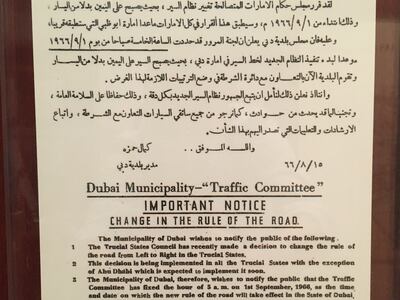Hanging on the wall of a museum in Dubai is a simple notice in black and white.
Dated August 1966, and signed by the director of Dubai Municipality, Kamal Hamza, it states that at 5am on September 1, Dubai will switch to right-hand driving.
Roundabouts would now move counter-clockwise and drivers overtake on the left.
“All drivers are requested to co-operate with police and to follow all instructions and directions which are issued to them,” it states.
Fifty-five years on, the switch may seem mundane. Traffic, the road network and the amount of cars was nothing like the dizzying, relentless pace of Sheikh Zayed Road today.

But the decision spoke to just how fast Dubai was transforming and why 1966 was a pivotal year.
US oil company Continental had discovered oil in commercial quantities in Dubai that year.
British exploration companies had spent many frustrating years in the search and now an American company had seemingly delivered the goods.
“That summer was [one of the most] optimistic moments in Dubai history,” said Todd Reisz, architect and author of Showpiece City: How Architecture Made Dubai.
“It seemed the oil that had transformed other Gulf countries was now coming to Dubai.”
Sheikh Rashid, Ruler of Dubai, had already embarked on a huge modernisation of transport links the year before. An airport opened in 1960 and the emirate got its first asphalt road the same year. Major roundabouts such as Deira’s Clocktower and the Flame Roundabout – built to celebrate the arrival of oil – stitched these new networks together, making connections to areas once considered remote and only accessible by 4x4.
“Everything done before 1966 was defined by the hope oil would happen to Dubai,” said Mr Reisz.
Now, with the discovery of oil, schools and housing were planned for American families set to stream into the 70,000-strong city. Dubai already had the busiest roads of the Trucial States and American cars such as Chevrolets and AMC Ramblers became popular. More traffic was inevitable, so what better time to make the switch?
“With fast-build, single-family homes extending across the district of Jumeirah, the city’s future already looked more American, and therefore suitable for the greatest American pastime – cruising in big shiny American cars,” said Mr Reisz. “By then, US-made cars dominated Dubai imports, and that was one reason the switch to the right lane made sense.”
There was no record of protest from the British at Dubai’s change to an American system.
“There was no sense of any nationalist response from British authorities at the time,” said Mr Reisz. “They respected Sheikh Rashid.”
Sheikh Rashid had proposed the driving change to the Trucial States Council, a group of the seven rulers established by the British to encourage co-operation. The notice stated that the switch was to be introduced across the Trucial States on September 1 apart from Abu Dhabi, which was “expected to implement it soon”. The motorway between Dubai and Abu Dhabi was still several years away.
The change came into effect at 5am that Thursday. Until 2006, Thursday marked the first day of the weekend and presumably authorities hoped roads would be even quieter. There is little record of any problems apart from some initial confusion in more congested parts of Dubai, but drivers, just like today, had grown to expect sudden changes on the roads.
“There is little evidence that anything happened,” said Mr Reisz. “There were some reports of issues in Deira but it was a Thursday morning.”
Aside from Dubai’s new-found love of American cars, the switch was part of a global trend. Dozens of countries made the change during the 20th century. Studies have shown the reasons have much to do with geography. Papers from the Arabian Gulf Digital Archive show how Qatar changed in 1965, while Bahrain and Sweden would do the same in 1967. More recently, in 2009, the pacific island of Samoa changed to the left, but today, the majority of countries and protectorates around the world follow right-hand rules.
Fifty-five years on, a copy of the notice still hangs in the Dubai Municipality Museum on the shores of the Creek. It speaks to a moment and time in the emirate's history where the initial euphoria of an oil discovery gave way to a more pragmatic approach as to how Dubai was going to become the global city it is today.
“Quickly the story switched to one we are familiar with,” said Mr Reisz.
“Dubai used ingenuity to create a city not dependent on oil wealth.”












